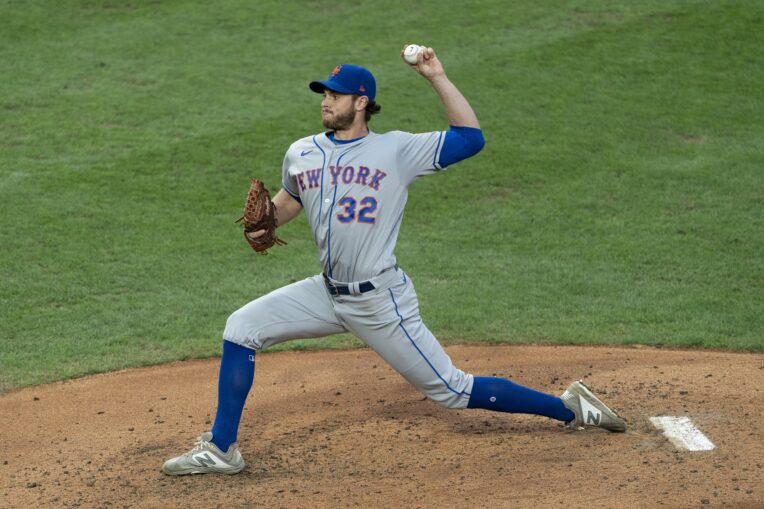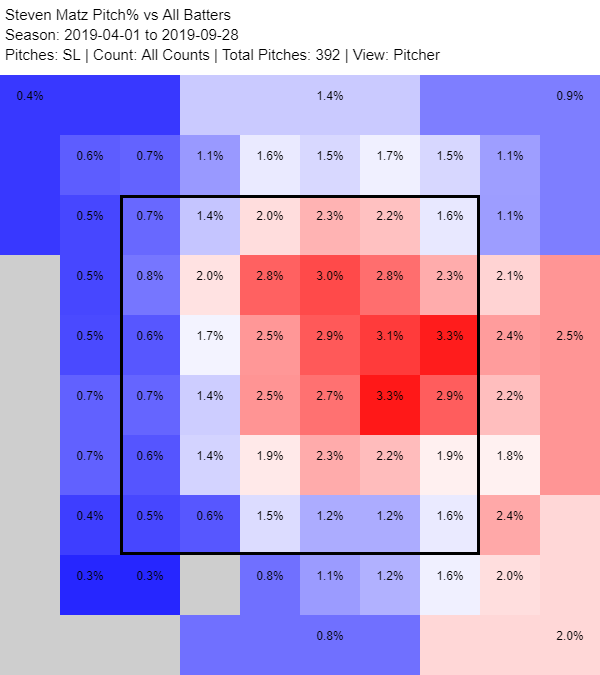
Before Major League Baseball’s shut down back in March, the New York Mets featured what they believed to be one of the deepest rotations in the game. Now months later, what was believed to be the team’s greatest strength has now become their biggest downfall midway through the season.
While Marcus Stroman‘s opt-out along with injuries to Michael Wacha and David Peterson haven’t helped the situation, Steven Matz‘s troubling performance has arguably been the team’s biggest issue thus far. And to make matters worse, it doesn’t seem like he’s on the verge of breaking out of this slump anytime soon.
After splitting time between the starting rotation and the bullpen last season, the Mets were hopeful Matz would become a crucial part of their pitching staff during the 2020 campaign. Unfortunately, the left-hander has already lost his spot in the rotation after five horrendous starts.
Over just 23.0 innings of work, the 29-year old hurler has produced an awful 9.00 ERA, 7.00 FIP, 4.32 xFIP, 212 ERA-, 158 FIP-, 1.57 WHIP, .306 OPP AVG, 28.4% LD rate, 33.8% GB rate, 32.1% HR/FB rate, 41.3% hard-hit rate, and a -0.3 fWAR rating as well.
As a result of these disappointing metrics, the majority of Matz’s numbers rank near the bottom of the league this season, which shouldn’t surprise anyone at this point. Among all qualified starters who’ve compiled at least 20.0 innings pitched, Matz owns the highest ERA-, 2nd-highest ERA, 3rd-highest FIP, FIP-, and HR/FB rate, and he’s also tied for the 3rd-lowest fWAR rating.
Despite maintaining his strikeout rate from last season (22.1%), one of the biggest concerns with the former second-round pick’s performance has been the lack of ground balls he’s induced, 13.3% decline from 2019. Additionally, he’s also allowed a concerning amount of line drives (8.6% increase), hard-contact (4.8% increase), and hasn’t been able to keep the ball in the yard, surrendering the second-most home runs (nine) in the majors.

So what’s caused the New York native’s numbers to climb so high in 2020? Well, the majority of the blame can’t be placed on his sinker, as its average velocity has increased by 1.3 mph. In addition, the 6-foot-2 hurler’s changeup has produced career-highs with its whiff rate (34.3%) and strikeout rate (32.6%). With that said, his curveball and slider have been trending in the wrong direction through the first half of the season.
Starting with his curveball, Matz relied on it 14.8% of the time in 2019, producing a .214 AVG, .178 xAVG, .411 SLG, .315 xSLG, .280 wOBA, .236 xwOBA, 26.6% whiff rate, 39.3% strikeout rate, 33.7% chase rate, 52.2% GB rate, 16.4% LD rate, 25.4% hard-hit rate, and a 7.5% barrel rate against it.
In comparison, the Ward Melville HS product has increased the usage of his primary breaking ball by 2.1% this season but hasn’t been able to replicate those same results. Over 12 batted ball events, it has generated a .438 AVG, .291 xAVG, .813 SLG, .621 xSLG, .514 wOBA, .372 xwOBA, 18.2% whiff rate, 25% strikeout rate, 30.6% chase rate, 41.7% GB rate, 33.3% LD rate, 58.3% hard-hit rate, along with a 16.7% barrel rate.
While the movements on his curveball haven’t drastically changed, averaging just two more inches of drop and 1.3 inches of break, Matz’s biggest issue has been the location of his breaking ball. Compared to last season, the veteran arm has failed to locate his second-best strikeout weapon consistently in 2020.
As seen below, Matz has been leaving his primary breaking ball in hittable parts of the strike zone this season, allowing hitters to create plenty of damage against it.

Source: Fangraphs.com
Unlike this season, the struggling lefty didn’t endure any command issues in 2019 and was able to consistently locate his curveball in the bottom half of the strike zone. As a result, he was able to induce plenty of soft contact and a ton of weakly hit ground balls.
Along with producing weak contact, this consistent location also helped Matz create a career-high 48 strikeouts against his breaking ball, which played a major factor in his ability to finish tied for the 23rd-most strikeouts in the NL.

Source: Fangraphs.com
Despite this small sample size, only 76 pitches, it’s clear Matz’s curveball hasn’t been sharp this season and he must find a way to correct his command issue to fight his way back into the rotation. Considering his changeup has developed into a productive strikeout weapon, owning a career-high 34.3% whiff rate, regaining his primary breaking ball would likely put him back on track as a starter.
Similar to his curveball, the hometown pitcher has also struggled to command his slider in 2020, which has prevented him from producing high amounts of ground balls and swings and misses with it. While it’s always been his fourth-best pitch, he was able to utilize his secondary breaking ball like never before last season, throwing it 14.5% (career-high) of the time.
In 2019, Matz recorded a .282 AVG, .256 xAVG, .459 SLG, .399 xSLG, .337 wOBA, .313 xwOBA, 19.7% whiff rate, 10.8% strikeout rate, 24.9% chase rate, 63.2% GB rate, 15.8% LD rate, 30.3% hard-hit rate, and a measly three degrees average launch angle.
This season, No. 32 has produced a .500 AVG, .317 xAVG, 2.000 SLG, .810 xSLG, .970 wOBA, .460 xwOBA, zero swings and misses and strikeouts, 12.5% chase rate, zero ground balls, 50% LD rate, 50% hard-hit rate, and an alarming 37 degrees average launch angle.
Considering opposing batters have crushed Matz’s slider in 2020, he’s been forced to reduce the usage of his breaking ball by 11.4%, utilizing it just 3.1%. But based on these terrible results, who could blame him for stashing it away and barely throwing it.

Source: Fangraphs.com
As seen above, nearly all 16 of Matz’s sliders have been located in the upper half of the strike zone, which certainly isn’t ideal for a pitch that averages less than 90 mph. To make matters worse, he’s also been leaving the majority of them down the middle of the plate and hitters haven’t been missing those poorly located pitches.
Even though the Mets’ left-hander faced a similar problem last season, he was much more effective at locating his secondary breaking ball to the right side of the strike zone – inside on right-handed batters and outside to left-handed batters. This made his fourth offering more deceptive and allowed him to keep the contact against it on the ground.

Source: Fangraphs.com
Considering Matz’s command struggles with his curveball and slider, the goal is very clear for him, he must become more consistent with the control of his breaking balls. If not, he’ll likely spend the remainder of this season as a bulk-innings reliever, or he may not even finish 2020 in the major leagues at all. Since the veteran still features one minor-league option, the Mets could potentially send him down to their alternate training site if he continues to struggle.
While manager Luis Rojas isn’t ready to move on from him as a starter just yet, that time could be coming soon and the final decision may come before the end of September or even August. Whenever the hard-throwing lefty earns another opportunity, even if it’s as a reliever, he’ll need to display some improvements to his craft.
Since Matz is slated to become a free agent after the 2021 season, this continues to be a very important stretch for him and with a few of the team’s top prospects starting to emerge from the minor leagues, there might not be a spot in the rotation for him in the near future.
















